According to Global Genes, the mean length of time from symptom onset to accurate diagnosis for patients with rare diseases is 4.8 years.
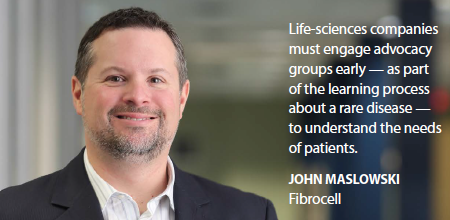 Late diagnosis delays the appropriate treatment and can lead to irreversible and sometimes debilitating complications or even life-threatening consequences, says Monika Dudzisz-Sledz, M.D., medical monitor, KCR.
Late diagnosis delays the appropriate treatment and can lead to irreversible and sometimes debilitating complications or even life-threatening consequences, says Monika Dudzisz-Sledz, M.D., medical monitor, KCR.
Furthermore, only 5% of the 7,000 rare diseases have an approved treatment, says Debbie Drell, director of membership services for the National Organization for Rare Disorders (NORD).
“Many rare diseases are life-altering or even life-threatening," she says. “For families of children with rare diseases, the hope and risk of intervention through a clinical trial can be the difference between life or death."
Defining the Communities
While one in 10 Americans are affected by rare diseases, many rare diseases do not have large patient populations on their own, and patients often struggle to find and connect with one another, says Alyse Sukalski, managing director at Cambridge BioMarketing.
Caterina Foca, Ph.D., project director, global project management, INC Research/inVentiv Health, says rare disease communities 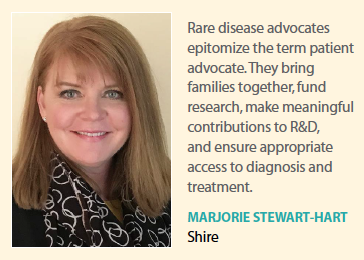 can feel isolated or ignored and often struggle to raise awareness for their disease.
can feel isolated or ignored and often struggle to raise awareness for their disease.
This is where rare disease communities have stepped in, helping patients and their caregivers feel less isolated, better informed, and more engaged in their health outcomes, experts say.
“The rare diseases patient communities have substantially changed and evolved over the past five to 10 years," Dr. Dudzisz-Sledz says.
According to Marjorie Stewart-Hart, head, U.S. and R&D patient advocacy at Shire, rare disease advocates epitomize the term “patient advocate."
“Patient advocacy groups raise funds for research; help define meaningful clinical endpoints; assist in the design of patient reported outcomes; design and manage registries; provide information on clinical trials; and help communicate about promising compounds," Ms. Stewart-Hart says. “They become members of regulatory decision-making bodies. They share their stories with legislators and media. They have a voice and a vote in health technology assessment in Europe and some other countries."
Laurie Bartolomeo, executive VP, creative director, Dudnyk, says these groups do everything from finding an expert, advocating for top treatment, managing side effects, and providing help and support for those coping with a heavily burdensome condition.
Chris Adams, co-founder and CEO of Cydan, says patient communities have become more sophisticated as experienced pharmaceutical and biotechnology executives have been recruited both to their advisory boards as well as to the operational side of the organization.
Important groups such as Rare Diseases International (RDI) have emerged, bringing together people living with a rare disease irrespective of their nationalities, Dr. Dudzisz-Sledz says.
Organizations such as Global Genes and NORD provide rare disease information for patients and their families, for doctors, on the insurance status, information for undiagnosed rare disease patients, patient assistance programs or help with accessing medicines, 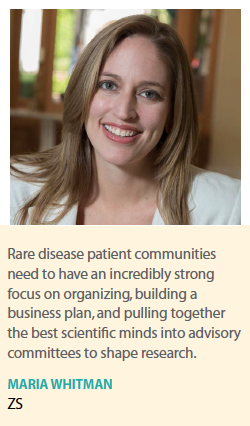 connecting with others, or finding other rare disease organizations, Dr. Dudzisz-Sledz says.
connecting with others, or finding other rare disease organizations, Dr. Dudzisz-Sledz says.
Ms. Drell says when NORD was first founded, patients would send handwritten letters requesting connections to others with their disease and staff would write to patients around the world trying to help them feel less isolated or alone with their diagnosis.
Addressing Concerns
The journey to diagnosis is a huge concern, and 40% of rare disease patients are misdiagnosed more than once, or diagnosis is delayed because rare diseases often hide behind symptoms of more common illnesses, Ms. Stewart-Hart says.
“Patients endure years of referrals to different specialists to find one that even recognizes their disease and can make a diagnosis," Ms. Sukalski says.
True experts may be hours or even states away, on top of which rare diseases often go hand in hand with complications — such as lowered immune systems — so anything can become a medical emergency.
“Companies and organizations working in rare diseases try hard to bridge this gap with physician finders and expert databases," she says.
Ms. Stewart-Hart says on this front Europe is setting the standard through the European Reference Networks, which expands rare disease knowledge sharing and care coordination across Europe to improve diagnosis and treatment.
Often there is no treatment for a patient’s condition, experts say. In fact, studies suggest 95% of rare diseases do not have any FDA-approved drug treatment.
Dr. Dudzisz-Sledz says that the number of treatments available for rare diseases has been dramatically increasing over the last 10 to 15 years as technology has advanced, human genome sequencing has become a standard laboratory analysis, and stem cell-based treatments have become more accessible and controlled.
“The real challenge now is to improve access to those medicines," she says.
Parents of children with rare diseases are constantly having to advocate for their child’s health, their education, and special services, Ms. Bartolomeo says. They’re dealing with multiple appointments, they’re fighting for services, and they’re battling insurance companies only to pay out of pocket for things their child cannot live without.
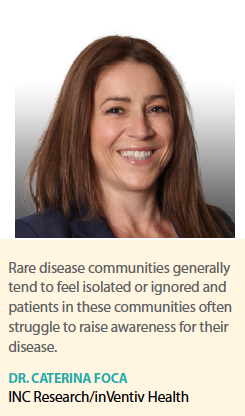 Michelle Schimmel, managing director, Rx Mosaic Health, says the most pervasive concern of patients living with rare diseases is the cost of being sick.
Michelle Schimmel, managing director, Rx Mosaic Health, says the most pervasive concern of patients living with rare diseases is the cost of being sick.
A recent Harvard Business Review article notes the average cost of a drug approved under the Orphan Drug Act of 1983 (ODA) is $118,820 per year.
“For those ‘lucky’ enough to have a condition where there is an approved treatment, there is always the underlying concern that they will not be able to afford it," Ms. Schimmel says. “For those with conditions where there is no approved treatment, the cost of care is still extraordinarily high when you consider alternative and supplemental therapies, doctor visits and hospitalizations, some of which are not covered by insurance."
Alexander Silver, co-founder, executive chairman, and CEO of the EB Research Partnership (EBRP), which is dedicated to funding EB research, says more money is needed to treat and cure rare diseases.
“Rare diseases impact 10% of the U.S. population, but nowhere near 10% of medical funds are spent on them," he says.
Mr. Silver describes the regulatory environment as one of his chief concerns.
“Gene editing and other cutting-edge technologies need to be safe; however, risk is relative," he says. “The risk of inaction for those with some rare diseases is death. This should play a large role in the regulatory pathway as many of the people living with rare diseases today don’t have the benefit of time."
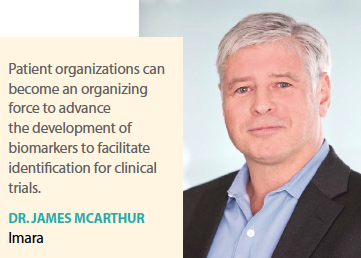 One of the challenges of many rare disease communities is that patients are represented by several groups, each with different goals and objectives, says James McArthur, Ph.D, CEO and co-founder of Imara.
One of the challenges of many rare disease communities is that patients are represented by several groups, each with different goals and objectives, says James McArthur, Ph.D, CEO and co-founder of Imara.
“In the absence of a unified effort, this transition from support and education, through enabling therapy development, to providing access to therapies is difficult to achieve," Dr. McArthur says.
The Relationship with Industry
According to the rare disease advocacy group Global Genes, about 50% of rare diseases do not have a disease-specific foundation supporting or researching their rare disease.
The relationship with patient communities is a delicate one and companies must not attempt to influence, direct, or guide patient advocates in mission development, goal-setting, policy prioritization, or program development and execution, Shire’s Ms. Stewart-Hart says.
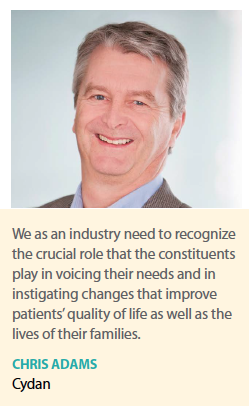 “Companies must first consult with patient advisory boards to discover what patients are struggling with, what kind of support they require from companies, and the role that patients envision companies play in their lives; then they speak with healthcare providers to discuss their concerns," Ms. Sukalski says.
“Companies must first consult with patient advisory boards to discover what patients are struggling with, what kind of support they require from companies, and the role that patients envision companies play in their lives; then they speak with healthcare providers to discuss their concerns," Ms. Sukalski says.
With compliance guidelines and policies in place, Shire will partner and collaborate with rare disease groups when the company’s interests and the groups’ interests intersect such as newborn screening, speed to diagnosis, access to expert care, and access to treatment.
“We keep advocates apprised of the progress of clinical studies, and offer access to our R&D, medical, or policy leadership," Ms. Stewart-Hart says. “We will connect advocates with leaders in the field if requested. We might provide meeting space or underwrite the cost of an independent meeting facilitator for a brainstorming session. We are elevating our approach to gathering advocate insights throughout the R&D lifecycle. Whatever form our support takes, the operative word is ‘listen.’ Patients are at the heart of what we do, and we need to understand and support what is important to them."
Maria Whitman, managing principal, ZS, says some pharmaceutical companies support rare disease communities’ research goals by working with patients early in the development process to co-create protocols and capture ethnographic insights about disease progression through documentation in natural history studies and patient registries.
“These types of partnerships require alignment between the missions of both the patient community and the pharma organization, as well as a mutual respect for one another’s mission," she says.
It’s important that companies understand that each patient organization must address the unique needs of its patients and their families and must maintain independence in the information they provide members, says Mary Dunkle, VP of educational initiatives at NORD.
A company looking to support a rare disease community has to let the community lead the way and champion patient-directed engagement, Ms. Schimmel says.
For example, Rx Mosaic Health partners with a pharmaceutical company on a community network that is informed by and created especially for MS patients. Now 200 patients strong, this program organically and continuously solicits topics that MS patients are most interested in hearing about, which enables the company to create resources that they know address unmet needs. The company’s role in this is to facilitate, connect, and share these efforts, but the true goal is to enable the community’s members to interact authentically among themselves.
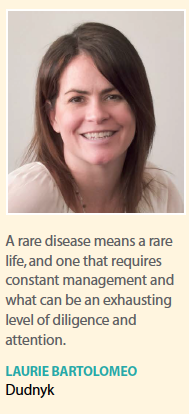 John Maslowski, CEO of Fibrocell, says interaction with advocacy groups is invaluable for a range of reasons — from gaining knowledge of natural history and epidemiology to standard of care and quality of life issues.
John Maslowski, CEO of Fibrocell, says interaction with advocacy groups is invaluable for a range of reasons — from gaining knowledge of natural history and epidemiology to standard of care and quality of life issues.
“Working with advocacy groups can help the life sciences industry to better understand patient needs and subsequently, develop therapies that offer the potential to be an advance in patient care and quality of life," he says.
Industry can play a role by building awareness through corporate communications and sponsorship and participation in projects developed by advocacy groups, Mr. Maslowski says.
Companies can also help to build tools, such as disease and treatment education websites and materials for patients and the physicians treating them, Ms. Sukalski says.
“Companies can support fundraising for awareness events and rare disease days to help bring advocacy communities together as well," she says.
Mr. Maslowski adds that industry must be prepared to show advocates that it is a trustworthy partner and patient care is the foremost goal of development efforts.
INC Research/inVentiv Health’s Dr. Foca adds that it’s important to understand that some patients don’t want a traditional therapy, treatment or procedure, so it’s imperative to establish trust and rapport with patient groups.
“Having information or knowledge on their disease presents the patients with options so that they can make a decision that best suits their needs," she says.
Another important issue is ensuring that patient-reported outcomes are included in the treatment plans, and there is an increased focus by patient communities to advocate for clinical trials outcomes that may not be accurately captured in the clinic, and to have patients partner closely with the life-sciences industry and regulators to co-create clinical trials protocols that capture these alternative patient-reported outcomes, Ms. Whitman says.
“For example, the six-minute walk test can be difficult for children to complete after a long walk to the hospital from the parking lot," she says. “However, patient communities are beginning to advise on more systematic ways to measure meaningful milestones, such as the ability to use a computer, brush their teeth, or feed themselves."
Ms. Whitman adds that annual congresses organized by patient communities not only bring patients and their families together with others living the same experiences, but have also been the nexus to bring new evidence to the FDA and pharmaceutical companies on important patient-reported outcomes and how to better capture endpoints for their disease.
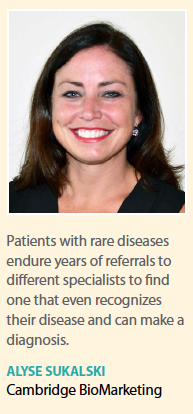 Experts say involving patients early in the clinical trial process gives guidance on measures and outcomes that matter to them and can help companies also ensure broader community engagement as treatment progresses.
Experts say involving patients early in the clinical trial process gives guidance on measures and outcomes that matter to them and can help companies also ensure broader community engagement as treatment progresses.
Changing the Conversation
Experts cite social media as important in breaking down barriers and helping patients with rare diseases to connect globally.
NORD’s Ms. Drell says Facebook hosts hundreds, maybe even thousands of, pages or groups for patients and families with rare diseases to connect, learn, and share information to spread awareness.
“Social media has played a role in helping patient communities to have a more prominent voice in decisions that impact their economic, social, and medical well-being," she says.
“Patients use their social media presence, for example, to discuss experiences with misdiagnosis, to openly solicit feedback on experiences with different medications, and to actively seek emotional support," Ms. Whitman says.
Rare disease communities rely on social media, Ms. Schimmel says.
Social media means that rare disease patients are no longer waiting for someone else to connect them.
“For example, Bo Bigelow, a father from Portland, Maine, created a Web page explaining his daughter Tess’s undiagnosed developmental disorder and asked readers to help find others like her," Ms. Schimmel says. “Once posted on Reddit, he was very quickly connected to a researcher investigating the disorder who was able to connect him to other patients with the disease."
Virtual communities such as Ben’s Friends and RareConnect are helping to connect patients and their families around the world, Ms. Stewart-Hart says.
Ms. Bartolomeo says as a mother of a child with a rare disease, she is grateful for the online connections she has made with other moms struggling with the same diagnosis in their children.
“We share our experiences — both good and bad, our stories, our support, and often our laughter and our tears," she says. “We discuss treatments, equipment, and methods for overcoming the daily challenges we all face."
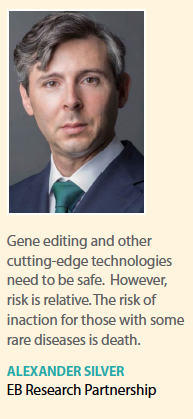 The group she joined less than seven years ago had fewer than 100 parents across the country and today that group has more than 4,000 members worldwide.
The group she joined less than seven years ago had fewer than 100 parents across the country and today that group has more than 4,000 members worldwide.
Rare disease advocates are integrating themselves into the drug review and approval processes and have become essential to rare disease policy-making, Ms. Stewart-Hart says.
She cites the example of the International Rare Diseases Research Consortium, which leverages the funding and commitment of governments around the world to spur drug discovery and development.
Ms. Whitman says changes in the regulatory environment have also supported the voice of rare patient communities. For example, the formation of the Office of Professional Affairs and Stakeholder Engagement and the Patient-Focused Drug Development Program further enables these groups to be part of the conversation.
Ms. Drell says that around 75% of NORD member organizations are actively funding rare disease research. Many are also starting their own rare disease registries to collect natural history data and help recruit patients for clinical trials.
“They are hosting scientific symposiums; drawing patients, families, and professionals together in cutting-edge conferences; and developing innovative educational programming for their communities," she says.
Ms. Whitman says patient communities are actively participating in public meetings and sharing information with the FDA on unmet community needs, the burden of disease and day-to-day management, which has helped the agency to prioritize efforts based on meaningful patient benefit.
“We also see these groups looking for more clinical trial availability and lobbying for novel trial endpoints that matter for the day-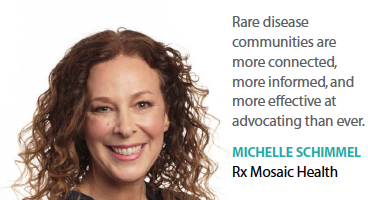 to-day care of the patient to ensure that manufacturers are not only thinking about a potential cure, but are also gathering evidence to support delayed disease progression or improved quality of life," she says.
to-day care of the patient to ensure that manufacturers are not only thinking about a potential cure, but are also gathering evidence to support delayed disease progression or improved quality of life," she says.
Globalization has helped to amplify the patient voice significantly, Ms. Stewart-Hart says.
“Rare disease is now part of health community conversations in Asia, Latin America, and parts of Africa, and patient organizations are evolving to guide those conversations," she adds.
We are off to a great start with digital tools, but we can do more, Ms. Sukalski says. For example, patients in rural, more disconnected areas around the world don’t have access to patient networks. That’s the next challenge for patient community networks. (PV)
~~~~~~~~~~~~~~~~~~~~~~~~~
Patient-Community Networks
Access to patient community networks is a priority for those suffering with rare diseases. Our experts share their views on networks that go above and beyond.
Chris Adams
Co-founder and CEO, Cydan
The Myotonic Dystrophy (DM) Foundation is focused on programs to deliver optimal care and support to DM patients with a balance between therapeutic, scientific progress and management of the disease. The organization has great leadership, specifically the CEO, and a global organization with an international effort to identify the most important clinical and scientific experts supporting a robust clinical research network.
Monika Dudzisz-Sledz, M.D.,
Medical Monitor, KCR
EURORDIS-Rare Diseases Europe is a unique, non-profit alliance of more than 700 rare disease patient organizations from more than 60 countries that work together to improve the lives of 30 million people living with a rare disease in Europe. By connecting patients, their families, and caregivers and connecting all stakeholders and rare disease communities, this organization empowers the patient and caregiver voice, improves research, and leads to improvement of patient services. EURORDIS played an important role in the development of the European Reference Networks for rare diseases (ERNs), whose goal is to ensure that no patient with a rare disease is left without help and to make it easier for patients to access information on healthcare and increase their treatment options. An important EURORDIS initiative is the platform named Rareconnect designed to provide a safe space for rare disease patients and their caregivers and families.
Mary Dunkle
VP of Educational Initiatives, National Organization for Rare Disorders
Three NORD member organizations come to mind — among many others — as examples of how patient organizations help advance progress for patients with diseases that are rare and little-known to the public or even within the medical community.
The Alport Syndrome Foundation has been active in mobilizing patients, supporting research, and encouraging awareness of the condition, which is characterized by progressive kidney disease and abnormalities of the ears and eyes, and the need for treatments. The organization has been supportive of research to map the course of Alport syndrome and patients are also being recruited for a clinical trial involving an investigational drug.
In 2015, Rapamune (sirolimus) was approved by the FDA to treat lymphangioleiomyomatosis (LAM), a rare, progressive lung disease that primarily affects young women of childbearing age. The LAM Foundation, through its research partnership with the MILES research team at the University of Cincinnati and the NIH Rare Diseases Clinical Research Network, played a very significant role in the research that ultimately led to this treatment. The foundation has provided many other important services to its patient and family community over the years, including developing a network of foundation-approved LAM clinics, and organizing LAMposium conferences to share the latest information.
X-linked hypophosphatemia is a genetic condition involving abnormal bone and tooth development and rickets that resists traditional vitamin D therapy. The XLH Network has recruited several of the leading experts on this condition to serve as its scientific advisers and works closely with them. For Rare Disease Day 2017, a patient representing the XLH Network served on a panel NORD helped organize at the Frank H. Netter MD School of Medicine at Quinnipiac University to teach future medical professionals about this condition. The network provides extensive information about XLH and current research on its website, and promotes participation in clinical trials.
James McArthur, Ph.D.
CEO and Co-founder, Imara
One great example I can think of for a patient group that is both progressive in its approach and provided successful outcomes for its community is The Friedreich’s Ataxia Research Alliance (FARA). FARA played an important role in promoting awareness of and enabling the enrollment of patients for the Phase III clinical trial of an investigational treatment — with trial enrollment completed in four months.
Michelle Schimmel
Managing Director,
Rx Mosaic Health
The Rett Syndrome patient community has been exciting to watch. With 15,000 girls and women in the United States and 350,000 globally, Rett was most certainly not on the map, but it got a powerful boost in 1999 with the discovery of MECP2, the gene linked to the condition. With the coming of age of social media and scientific progress converging around 2008, the Rett Syndrome Research Trust was born. This organization has one single mission: to find a cure. It is unapologetically aggressive in its mission and its efforts to make that happen. This line in the sand invigorated and galvanized this community — caregivers, patients, advocacy organizations, and researchers alike — to do everything possible to achieve this mission. With this, a fully connected and supportive global community emerged. There are closed group discussions, patient-initiated living, and QoL tips and support forums, but what is so incredibly powerful about this community is the responsibility they all feel toward meeting this goal. This common mission has given them hope even as they struggle day to day with the impact of this disease.
Marjorie Stewart-Hart
Head, U.S. and R&D
Patient Advocacy, Shire
The Pulmonary Hypertension Association (PHA) was founded around a kitchen table 25 years ago, and since then it has evolved into the largest PH association in the world. During that time, PHA has provided more than $17 million for research, the number of FDA-approved treatments has grown from none to 14, and more than 12 pulmonary hypertension care centers have completed PHA’s accreditation process. PHA has a strong presence in the United States, including 240 local support groups, and partnerships with other PH associations across the globe. It also makes a meaningful difference to the training of medical professionals.
Alyse Sukalski
Managing Director, Cambridge
BioMarketing
Global Genes does an excellent job bringing the community together. The group started as a small, grassroots effort and after almost 10 years, it has grown to have hundreds of organizations in its network.
The EveryLife Foundation also does great work. It is run with the goal of fixing the drug development process. Not only is the foundation involved in legislation, but it also hosts rare disease-focused events to bring the community together. The foundation has examined the trial process, focused on getting new biomarkers accepted in clinical trials so that drugs can be developed and approved faster. The organization aims to deliver critical information to patients in need of answers.

















